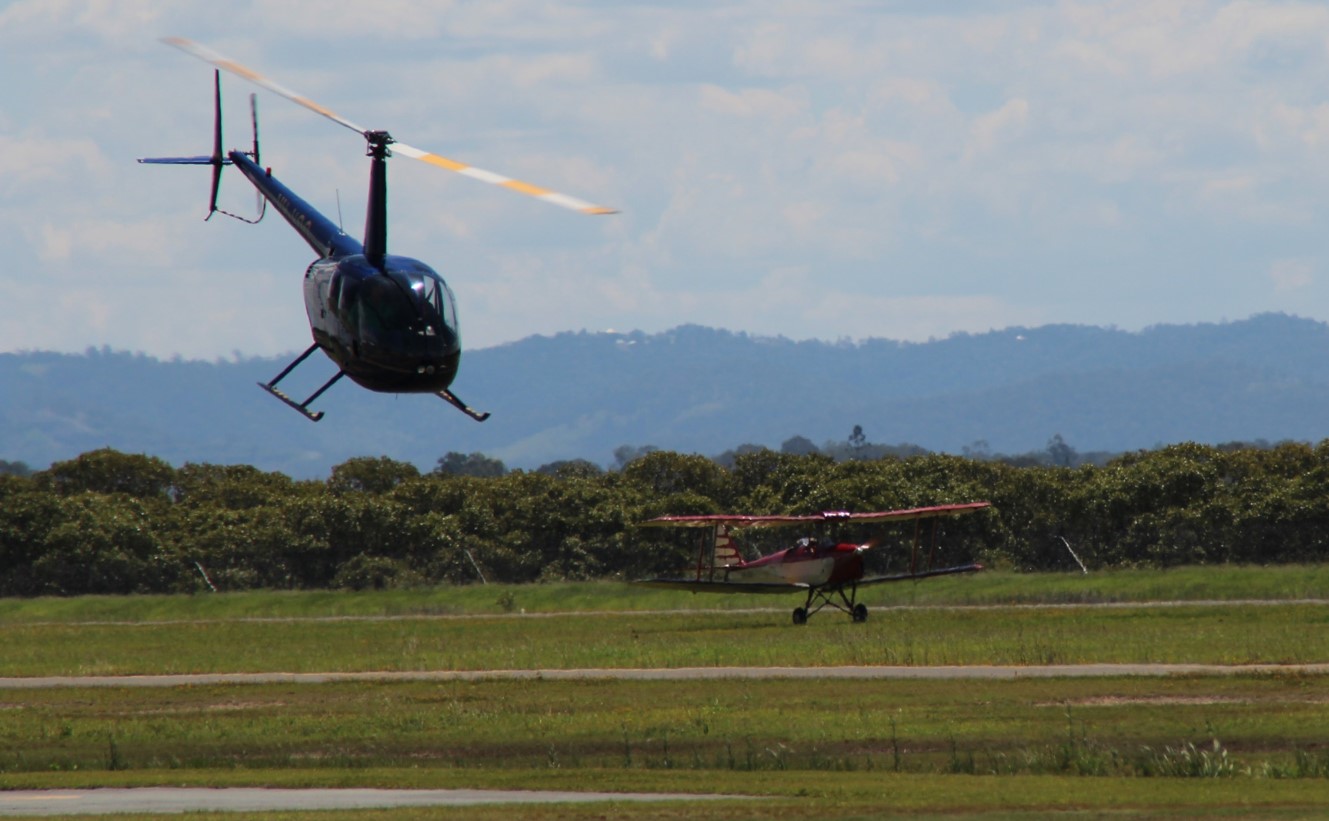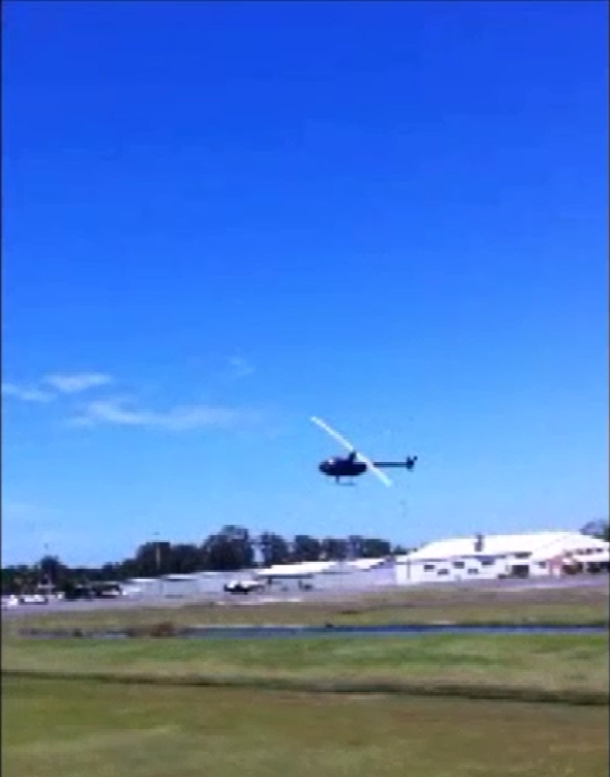What happened
Early in the afternoon on 7 November 2015, a Robinson R44 helicopter, registered VH-HOQ (HOQ), was conducting pilot training on the western end of Redcliffe aerodrome, Queensland. HOQ was conducting a training sortie and had an instructor and student on board. The training involved practicing engine failures in the hover and while taxiing. Their operations were confined within the aerodrome boundary (Figure 1) and clear of the runway and taxiway. They had completed the initial part of the sortie on the grass area to the south of the taxiway.
Figure 1: Redcliffe Aerodrome layout showing the approximate position of the aerodrome boundary (yellow)

Source: Google Maps. Modified by ATSB
At the same time, a de Havilland DH82A (Tiger Moth), registered VHBJE (BJE), was taxiing for departure on runway 07. BJE was departing for a scenic flight with the pilot and one passenger on board. Both aircraft were operating under the visual flight rules,[1] and the weather conditions were fine and clear.
While BJE was taxiing for Runway 07, HOQ moved to the grassed area just north of the taxiway to practice engine failures while taxiing. These manoeuvres involved the helicopter flying at low level parallel to the taxiway and landing on the grass. Once they had reached the eastern end of the grass area the instructor would taxi back to the start point to allow more training to occur.
Due to the nature of the helicopter training being conducted, the focus of the instructor and student was reduced to their immediate operations. During the transit from the grassed area to the area next to the taxiway HOQ did not advise the change in operating area on the common traffic advisory frequency (CTAF)[2] to other aircraft. While they were aware of the Tiger Moth, they did not consider it to be a concern. This was because the helicopter operations were going to remain clear of where the Tiger Moth was intending to operate.
The pilot of BJE broadcast their intentions to taxi and enter the runway to other aircraft in the area on the Redcliffe CTAF. There were no other radio transmissions by other aircraft while BJE was taxiing and entering the runway. While taxiing, the pilot of BJE noted the position of the helicopter and saw that it was well clear. The pilot of BJE therefore did not expect that the helicopter would change operating area to conflict with their departure.
The pilot of BJE lined up for departure on the grass beside the runway, because the aircraft was fitted with a tail skid, not a tail wheel. The grass area for BJE’s take off was within the runway strip to the side of the runway closest to the taxiway. BJE commenced the take-off run and, shortly after, the pilot noticed HOQ flying on a parallel track to BJE (Figure 2). The helicopter was to the right, slightly ahead and above BJE, and in close proximity.
Figure 2: BJE during the take-off run just prior to HOQ conducting the left turn

Source: Observer
Shortly after becoming airborne from the grass runway, at about 50 to 60 ft above ground level (AGL), the pilot of BJE saw the helicopter commence a left turn towards the runway. Thinking that there was going to be a collision, the pilot of BJE took avoiding action by conducting a hard left turn, with a high angle of bank, at low altitude. The approximate tracks of the aircraft are depicted in Figure 3.
Figure 3: Redcliffe aerodrome showing the runway strip (white). The take-off run and left turn of BJE is indicated in orange. The track of HOQ when conducting the engine failures during taxi and the reversal turn is indicated in blue.

Source: Google Maps. Modified by ATSB
The instructor in HOQ was executing a reversal turn in order to reposition the helicopter for further training (Figure 4). The manoeuvre involved a 180-degree left turn, to reverse the direction of flight, with an increase in height to about 50-60ft and a bank angle of about 50o. The turn and track back down the grassed area would keep the helicopter outside the runway strip and clear of BJE. However, as the instructor had not advised their intentions on the CTAF, the pilot of BJE was unaware that the helicopter was going to remain clear of the aircraft.
Figure 4: View from the Tiger Moth when the helicopter was approximately half way through the reversal turn
Source: Video from passenger
Pilot comments
Instructor, HOQ: Teaching, demonstrating, and conducting, practice engine failures at low level is a very high demand task. The instructor’s attention is, predominantly, directly ahead of the aircraft and in closely monitoring the student control inputs. This is to ensure that the student is executing the correct technique and safely executing the manoeuvre to avoid damage to the aircraft.
The operations in between the taxiway and the runway strip were going to be conducted so that they would always remain clear of other aircraft operating on the runway. The instructor did not advise the change in operating area as he assessed that there would be no conflict between the aircraft.
Pilot in Command, BJE: During the taxi to the runway the pilot noted the position of HOQ. At this time HOQ was operating to the south of the taxiway and not near the runway. The next time that the pilot of BJE saw HOQ was just after commencing the take-off roll. This surprised the pilot of BJE as he had not heard any transmissions advising that HOQ had changed their operating area. As a result, when HOQ commenced the reversal turn, he assessed that a collision was imminent. To avoid the possibility of a collision, the pilot of BJE turned the aircraft away to the left. The turn was made at low level, with a high angle of bank and at a relatively slow airspeed.
ATSB comment
Both pilots were monitoring the CTAF and the pilot of BJE had transmitted their intentions correctly. However, as the instructor of HOQ did not advise that they were going to conduct the reversal turn, the pilot of BJE did not know that the helicopter would remain outside the runway strip. The avoiding action taken by the pilot of BJE in this case may have been avoided if the helicopter pilot had communicated their intentions.
Safety message
Pilots are encouraged to ‘err on the side of caution’ when considering when to make broadcasts on CTAF, particularly when the aircraft operations are likely to be in close proximity to other aircraft.
Insufficient communication between pilots operating in the same area is the most common cause of safety incidents near non-controlled aerodromes.
- A search for other traffic is eight times more effective when a radio is used in combination with a visual lookout than when no radio is used.
The CASA booklet titled Operations at non-controlled aerodromes provides guidance with respect to the limitations of the see-and-avoid principle and relevant radio procedures. Civil Aviation Advisory Publication 166-1 also provides relevant guidance with respect to CTAF procedures.
Aviation Short Investigations Bulletin - Issue 47
Purpose of safety investigationsThe objective of a safety investigation is to enhance transport safety. This is done through:
It is not a function of the ATSB to apportion blame or provide a means for determining liability. At the same time, an investigation report must include factual material of sufficient weight to support the analysis and findings. At all times the ATSB endeavours to balance the use of material that could imply adverse comment with the need to properly explain what happened, and why, in a fair and unbiased manner. The ATSB does not investigate for the purpose of taking administrative, regulatory or criminal action. TerminologyAn explanation of terminology used in ATSB investigation reports is available here. This includes terms such as occurrence, contributing factor, other factor that increased risk, and safety issue. Publishing informationReleased in accordance with section 25 of the Transport Safety Investigation Act 2003 Published by: Australian Transport Safety Bureau © Commonwealth of Australia 2016
Ownership of intellectual property rights in this publication Unless otherwise noted, copyright (and any other intellectual property rights, if any) in this report publication is owned by the Commonwealth of Australia. Creative Commons licence With the exception of the Coat of Arms, ATSB logo, and photos and graphics in which a third party holds copyright, this publication is licensed under a Creative Commons Attribution 3.0 Australia licence. Creative Commons Attribution 3.0 Australia Licence is a standard form licence agreement that allows you to copy, distribute, transmit and adapt this publication provided that you attribute the work. The ATSB’s preference is that you attribute this publication (and any material sourced from it) using the following wording: Source: Australian Transport Safety Bureau Copyright in material obtained from other agencies, private individuals or organisations, belongs to those agencies, individuals or organisations. Where you wish to use their material, you will need to contact them directly. |
__________
- Visual Flight Rules (VFR): Rules that allow a pilot to operate an aircraft in weather conditions that are generally clear enough to allow the pilot to see where the aircraft is going.
- The CTAF is the frequency on which pilots operating at a non-controlled aerodrome should make positional radio broadcasts.


